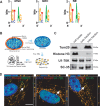Evidence of nuclei-encoded spliceosome mediating splicing of mitochondrial RNA
- PMID: 28430982
- PMCID: PMC6075211
- DOI: 10.1093/hmg/ddx142
Evidence of nuclei-encoded spliceosome mediating splicing of mitochondrial RNA
Erratum in
-
Evidence of nuclei-encoded spliceosome mediating splicing of mitochondrial RNA.Hum Mol Genet. 2017 Jul 1;26(13):2590. doi: 10.1093/hmg/ddx220. Hum Mol Genet. 2017. PMID: 28637317 Free PMC article. No abstract available.
Abstract
Mitochondria are thought to have originated as free-living prokaryotes. Mitochondria organelles have small circular genomes with substantial structural and genetic similarity to bacteria. Contrary to the prevailing concept of intronless mitochondria, here we present evidence that mitochondrial RNA transcripts (mtRNA) are not limited to policystronic molecules, but also processed as nuclei-like transcripts that are differentially spliced and expressed in a cell-type specific manner. The presence of canonical splice sites in the mtRNA introns and of core components of the nuclei-encoded spliceosome machinery within the mitochondrial organelle suggest that nuclei-encoded spliceosome can mediate splicing of mtRNA.
© The Author 2017. Published by Oxford University Press. All rights reserved. For Permissions, please email: journals.permissions@oup.com.
Figures




Similar articles
-
Organellar maturases: A window into the evolution of the spliceosome.Biochim Biophys Acta. 2015 Sep;1847(9):798-808. doi: 10.1016/j.bbabio.2015.01.009. Epub 2015 Jan 24. Biochim Biophys Acta. 2015. PMID: 25626174 Review.
-
Trans-splicing of organelle introns--a detour to continuous RNAs.Bioessays. 2009 Sep;31(9):921-34. doi: 10.1002/bies.200900036. Bioessays. 2009. PMID: 19644921 Review.
-
The low information content of Neurospora splicing signals: implications for RNA splicing and intron origin.RNA. 2015 May;21(5):997-1004. doi: 10.1261/rna.047985.114. Epub 2015 Mar 24. RNA. 2015. PMID: 25805857 Free PMC article.
-
The significant other: splicing by the minor spliceosome.Wiley Interdiscip Rev RNA. 2013 Jan-Feb;4(1):61-76. doi: 10.1002/wrna.1141. Epub 2012 Oct 16. Wiley Interdiscip Rev RNA. 2013. PMID: 23074130 Free PMC article. Review.
-
Nuclearly encoded splicing factors implicated in RNA splicing in higher plant organelles.Mol Plant. 2010 Jul;3(4):691-705. doi: 10.1093/mp/ssq025. Epub 2010 Jul 5. Mol Plant. 2010. PMID: 20603383 Review.
Cited by
-
Using deep long-read RNAseq in Alzheimer's disease brain to assess medical relevance of RNA isoform diversity.bioRxiv [Preprint]. 2023 Dec 11:2023.08.06.552162. doi: 10.1101/2023.08.06.552162. bioRxiv. 2023. Update in: Nat Biotechnol. 2025 Apr;43(4):635-646. doi: 10.1038/s41587-024-02245-9. PMID: 37609156 Free PMC article. Updated. Preprint.
-
Human mtDNA-Encoded Long ncRNAs: Knotty Molecules and Complex Functions.Int J Mol Sci. 2024 Jan 25;25(3):1502. doi: 10.3390/ijms25031502. Int J Mol Sci. 2024. PMID: 38338781 Free PMC article. Review.
-
Mitochondrion-encoded circular RNAs are widespread and translatable in plants.Plant Physiol. 2022 Jun 27;189(3):1482-1500. doi: 10.1093/plphys/kiac143. Plant Physiol. 2022. PMID: 35325205 Free PMC article.
-
Editorial: Regulation of Mitochondrial Function on Animal Diseases.Front Vet Sci. 2022 Jun 17;9:943860. doi: 10.3389/fvets.2022.943860. eCollection 2022. Front Vet Sci. 2022. PMID: 35782556 Free PMC article. No abstract available.
-
The Roles of CircRNAs in Mitochondria.J Cancer. 2024 Mar 17;15(9):2759-2769. doi: 10.7150/jca.92111. eCollection 2024. J Cancer. 2024. PMID: 38577612 Free PMC article. Review.
References
-
- Asin-Cayuela J., Gustafsson C.M. (2007) Mitochondrial transcription and its regulation in mammalian cells. Trends Biochem. Sci., 32, 111–117. - PubMed
-
- Timmis J.N., Ayliffe M.A., Huang C.Y., Martin W. (2004) Endosymbiotic gene transfer: organelle genomes forge eukaryotic chromosomes. Nat. Rev. Genet., 5, 123–135. - PubMed
-
- Gray M.W. (1999) Mitochondrial Evolution. Science, 283, 1476–1481. - PubMed
MeSH terms
Substances
Grants and funding
LinkOut - more resources
Full Text Sources
Other Literature Sources
Molecular Biology Databases

